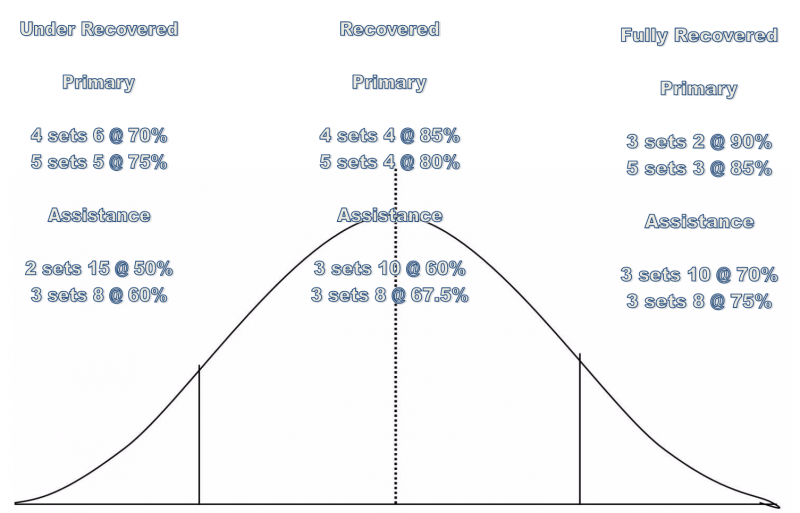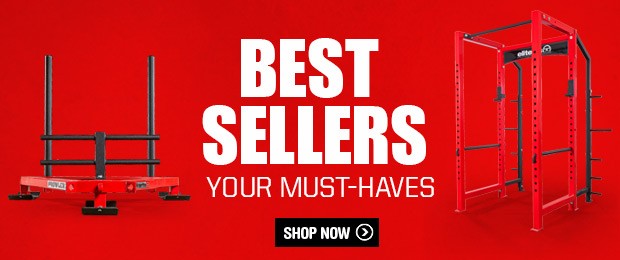
I first released Engineering Physical Performance in 2013, and since then I have had a number of comments about the training programs within. In particular, I've had questions about which loading patterns I feel are the best and how they should be applied. So with this in mind, I offer this article addendum to review my philosophy and to tweak a few elements of the training plan for even better gains in strength and size.
I have been a huge believer in the use of the Intensity Number of Lifts (INOL) to develop programs that are achievable and follow a sensible loading pattern over time. I had previously used four sets of six with 75% as a deload week, but in reality, this needs to be reassessed utilizing the INOL model, as the reality of this loading protocol is that this deload week is effectively the first week of a new cycle, since it gives an INOL of 0.96.
With this oversight corrected, let us plan out a three-phase training plan, paying close attention to the INOL in relation to the lifting progressions.
Single Exercise Guidelines (Hristov, 2005)
If you do not already know your training max for a particular exercise, then I recommend the following methods to achieve this as a starting point to develop your program.
- Do four sets of six as a progressive overload, planning to achieve concentric failure during the fourth set, somewhere between two and six reps. If you can still get six reps you have gone too light and may need to perform an additional set. This method works well with intermediate lifters. You can then apply the formula: Weight x Reps x 0.0333 + Weight = Estimated 1RM.
- Do sets of five, four, three, two, and then one, progressively working up to a training max single repetition. If you achieved this comfortably then you can perform an additional extra set or two sets of single reps. This will allow for a true training max to work from. This method works well with intermediate to more advanced lifters.
- Do ramp singles, working up to a true training max, usually within five or six single attempts. I recommend this for advanced lifters.
Whichever method you use, you now have a max load number to program from. The system I really like to work from is a wave loading method, working up to a max double over three weeks of loading.
Six Sets Loading Cycle (Wave Loading)
- Preliminary Week: 4 x 6 with 75% = INOL 0.96
- Week 1: 2 x (6/5/4) with 75%, 80%, and 85%
- Week 2: 2 x (5/4/3) with 80%, 85%, and 90%
- Week 3: 2 x (4/3/2) with 85%, 90%, and 95%
For the second wave, you can increase by a small increment by using fractional weights. It has been my experience that the load can be increased by around 2.5% for the second wave, but this is by no means a universal law.
To analyze this using the INOL and taking into consideration the second wave with an increase of 2.5% on the load of the first wave, the calculations for each single exercise will be:
- Week 1: 6/25 + 5/20 + 4/15 + 6/22.5 + 5/17.5 + 4/ 12.5 = 1.64 INOL
- Week 2: 5/20 + 4/15 + 3/10 + 5/17.5 + 4/12.5 + 3/7.5 = 1.83 INOL
- Week 3: 4/15 + 3/10 + 2/5 + 4/12.5 + 3/7.5 + 2/2.5 = 2.49 INOL
- Deload Week – 3 x 8 with 60%, which is 24/40 = 0.6 INOL
Following this deload week, you could go straight back into another loading phase as listed above, working off of a new estimated 1RM from the heaviest double you achieved in the loading cycle, or you could change up gears and move onto another method of training.
Either one of these two loading cycles would be a great follow-up to the wave loading method, with the preliminary week still being four sets of six with 75% as a loading start point for each new cycle, followed by a down load after each cycle of three sets of eight with 60.
Six Sets Loading Cycle (Strength)
- Week 1: 5 x 5 with 80%
- Week 2: 2 x 5 with 80%, 85% and 3 x 3 with 87.5%, 90% and 92.5%
- Week 3: 5/4/3/2/1 with 80%, 85%, 90%, 95%, and 100%+
- Four Sets Loading Cycle (Clusters – Intra-Set Rest Periods)
- Week 1: 4 x (3/3) with 85%, 20 seconds rest
- Week 2: 4 x (2/2/2) with 90%, 20 seconds rest
- Week 3: 4 x (3/2/1) or 4 x (1/1/1/1/1/1) with 95%, 20 to 30 seconds rest
The use of the INOL is certainly a great way to modulate intensities both over a training cycle and also to examine subjective and objective measures of recovery and readiness to train.
A weekly program is included below to show readers how I would put together the program based on INOL and readiness.
Workout Exercise Options
See bell curve chart for sets and reps options.
Push Workout
- Squat Option (Back, Front, Box, Zercher)
- Single-Leg Option (Sprinter Squat, Walking Lunge, Step-Up)
- Upper Body Push Option Primary (Military Press, Incline Bench, Bench)
- Upper Body Push Option Secondary (Any Dumbbell or Lighter Barbell Variation)
Pull Workout
- Olympic (Jerk, Clean and Snatch variations)
- Hamstring (Nordic, Single-Leg Deadlift, Single-Leg Stiff Leg, Foot against Wall Single-Leg Deadlift)
- Upper Body Pull Primary (Barbell Row, Chin-Up, Pull-Up, Yates Row, Pendlay Row)
- Upper Body Pull Secondary (Any Dumbbell or Lighter Barbell Variation)
Full Body Workout
- Olympic or Hamstring
- Squat or Single-Leg
- Upper Body Push (Military Press, Incline Bench, Bench)
- Upper Body Pull (Barbell Row, Chin-Up, Pull-Up, Yates Row, Pendlay Row)
Loading Cycles
Primary Loading Exercises
- Week 1: 4 x 6 with 70% INOL of 0.8 (24 reps)
- Week 2: 5 x 4 with 80% INOL of 1.0 (20 reps)
- Week 3: 6 x 2 with 90% INOL of 1.2 (12 reps)
I would use the primary loading cycle on Olympic lifts, squat, lower back/hamstring, and upper body barbell movements.
Secondary Loading Exercises
- Week 1: 2 x 12 with 60% INOL of 0.6 (24 reps)
- Week 2: 3 x 10 with 67.5% INOL of 0.9 (30 reps)
- Week 3: 4 x 8 with 75% INOL of 1.3 (32 reps)
I would use the secondary loading cycle on single-leg movements, secondary lower back/hamstring, and dumbbell/kettlebell exercises.
If I wanted to introduce a shock loading microcycle I could choose any of the below patterns, as they all have an INOL of 2:
- 5 x 1 with 97.5%
- 5 x 2 with 95%
- 5 x 3 with 92.5%
- 5 x 4 with 90%
- 5 x 5 with 87.5%
- 5 x 6 with 85%
- 6 x 6 with 82.5%
Using the INOL as a recovery training tool, you can see that RED would be for a player who does not feel 100% ready to go, AMBER would be okay but not 100%, and GREEN is good to go. The protocol of sets and reps vary appropriately on these categories.
Here is the full INOL chart for you to plan from:
INOL Chart
This is a programming variation that my strength coach came up with. He is a brilliant strength coach and I think this programming spreadsheet shows this:














The level of content and information you provide is unmatched in my opinion. I've been using it on and off for a while now, most recently with the "extended 30's" article you put out a while ago it really helped my BP.
When you use the beastly complexes what rest period do you tend to use between rounds? would you decrease it over a period of time as a means of progression?
Your posts are just brilliant. Thank you! One quick question. In that Edinburgh template - I take it these are all just basic templates. But how come you're only doing three days a week for size and then a lot more volume for strength? Would you perform extra high-rep upper body sessions, strong man circuits, etc. for size?
Cheers
Greg
Can't thank you enough for all the fantastic information that you provide. Quick question regarding load monitoring. I am just curious if you and your coaches use other forms of load monitoring apart from INOL or do you find using INOL is more than sufficient. The second question is, in the template I can see INOL is monitored weekly, have you ever used it as an acute:chronic load ratio to monitor for increased injury potential and if so, how did it work out for you?
In the past I have only used RPE and time. I feel I have not monitored correctly to give any advice as to how it worked. I then got caught up in the pre-season (had 15 guys out of 50 come to pre-season trials still rehabbing) and forgot completely about my interests in this.
I will have more time this season to try and implement some of my thoughts properly and have a couple of months to prepare the method to get it right.
did you have any success last season?